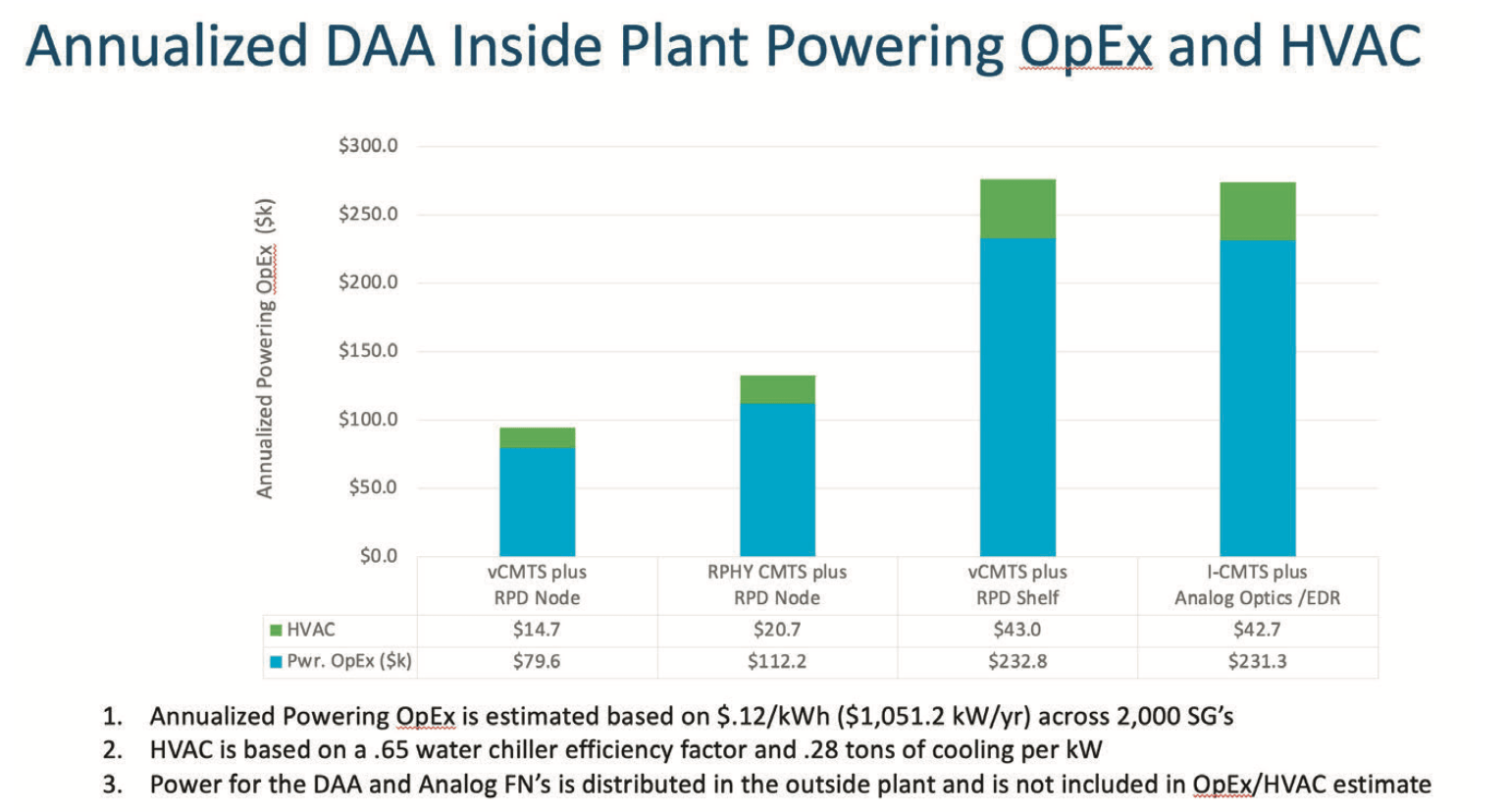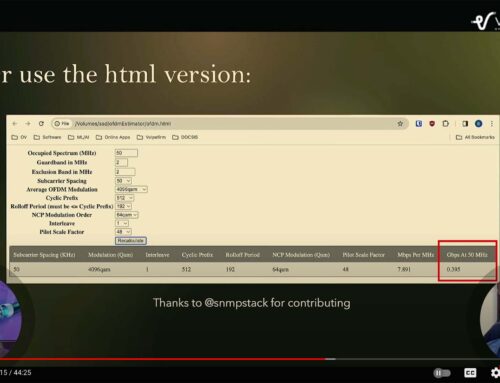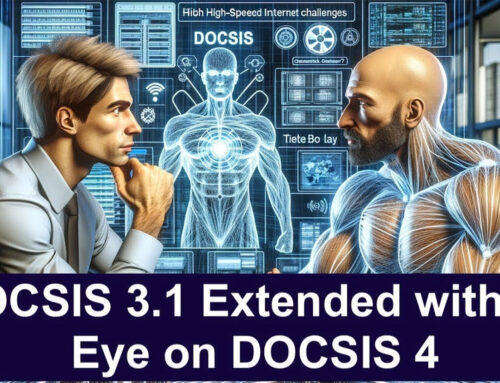DOCSIS is Green (full length). Shorter and cleaner version is seen in Broadband Library DOCSIS Going Green.
The simplest solution is almost always the best. Through technological advancements we can do more with less.
There are important discussions happening about green initiatives in our industry. Usually on the consumer electronics side. According to the NCTA “Cable operators, video programmers, equipment manufacturers, research labs and others are now providing a more energy efficient experience that is saving consumers millions of dollars in energy bills and preventing millions of metric tons of carbon dioxide emissions.”[1]
In general, there are also many discussions about alternative energy. Even with alternative energy it is easy to forget we still use energy even if it’s green. Alternative energy will also not offset rising energy prices. There is an additional way to gain a benefit to either your electric bill or the environment. Occam’s Razor states: “the simplest solution is almost always the best.”[2] Consume less power. So, what does this have to do with DOCSIS?

Figure 1: NCTA: Groundbreaking program saves customers money & reduces emissions [3]
The traditional legacy analog CMTS is not sustainable
“MSOs have long relied on CMTS hardware and analog optics located in the headend or hubsite to provide high speed data services. This architecture has served MSOs well for more than 20 years. And until just a few years ago, an area with 500 homes could be served by a single CMTS. As higher bandwidth services were deployed, a 500-home service group has meant over-utilization, especially during peak hours. Subscribers suffered from slow data speeds. Cable operators were required to split nodes and divide service groups to serve 150 or fewer homes, add more fiber nodes, activate additional CMTS ports, and increase powering and HVAC. Based on current and projected growth in demand, expansion with this service delivery platform is just not sustainable.” [4]
Looking to the immediate future, most MSOs are targeting service groups with 100 or fewer homes with the corresponding requirements in CAPEX and OPEX investments. This means more power, heat, and space if nothing else changes. This is a tough situation for cable operators. Costs increase, more regulatory constraints and consumers focus more heavily on the environment not only on what they are consuming but also those are them. Another factor in the equation is sustainability. While green initiatives are good, sustainability also matters and should be a factor in our thinking. We need to find ways to make what we have do its job longer and be more versatile for longer.
Virtual CMTS
Virtual CMTS (vCMTS) are the future. They reduce power, HVAC costs, and space usage.
In speaking with Cisco and Harmonic on virtual CMTSs (vCMTS), both agree that the total cost of ownership (TCO) for a vCMTS is roughly 50%-65% of legacy analog CMTSs. The cost savings comes in multiple forms. First, it is realized in up front purchase cost of commodity servers and remote PHY (R-PHY) devices. This is an immediate reduction in hardware costs for your network, especially if you are looking to upgrade from DOCSIS 3.0 to 3.1.
Next is powering. A few vCMTS servers require an order of magnitude less power than the legacy CMTS. This is a significant savings that is realized year over year and also benefits the environment by reducing carbon emissions. Secondary savings need to be considered when calculating TCO. For example, HVAC (cooling) costs will go down when the total power generated by legacy CMTS is removed. Instead of large legacy analog CMTSs generating a substantial amount of heat, vCMTS’s generate a fraction of heat. It’s good for the bottom line, the headend and the environment.
A vCMTSs with distributed access architecture (DAA) uses less power than a legacy CMTSs and legacy optics or enhanced digital return (EDR). According to Cisco, a legacy system will use $274k per service group per year while a vCMTS with DAA will consume only $94.3k per service group per year (see Figure 2 for assumptions). That is a 65% reduction in power and HVAC each year over year. This does not take into consideration the savings in headend/hubsite space! Further, as the number of users and data consumption continues to grow, so will the number of service groups. Even if the population rates remain steady in your area the amount of data used will continue to increase so these numbers are still significant even for small operators. vCMTSs are the way forward especially when calculating powering savings, sustainability and adaptability.

Figure 2: Annualized vCMTS + DAA Powering vs. I-CMTS w/Analog Optics (image courtesy Cisco Systems) [5]
vCMTS Adaptivity
I’ve covered virtual CMTSs for years [https://bit.ly/vcmts] and mostly focused on their adaptivity, such as their ease to upgrade and expandability into other domains. For example, vCMTS software can easily be upgraded to support other services such as PON and 5G. That alone makes them the way of the future because a vCMTS is software driven. It has the flexibility to be upgraded with software to support technologies other than just DOCSIS, which is just needed in today’s networks. It’s very beneficial and future optimized for cable operators. Now your PON and 5G hardware can be as green as your DOCSIS CMTS and its all converged together. This is power savings, space savings, adaptability and optimization!
At the ANGACOM 2021 show during the Q&A sessions Jason Miller, Technical Marketing Engineer of Cisco Systems discussed how “virtual CCAP with new processors enables more speed with less power”. He further indicated the increased value of vCMTSs over chassis based CMTSs due to the long “time to integrate the latest and greatest features” in legacy CMTSs was significant. Gary Hammer, SVP at Smartlabs discussed how all European customers are very energy conscious. In his words, “the Gretta impact has been huge” and Smartlabs is working hard at “reducing set top power usage and enabling set top auto power off.” Jorge Figueroa of Harmonic discussed how “Virtualized solution allows customer to converge multiple access platforms into a single set of servers, so power and cooling are greatly reduced, which help the environment.” From the headend to the home, the message was clear, reducing energy has become a priority in Europe. In North America, as we see energy prices increase and mixed with a concern for the environment, we need to focus on our energy consumption.
An electric bill from Germany shows not only what you are using, what other households use and where your energy is coming from.

Figure 3. Individual power usage compared to others in Germany.

Figure 4. How power is generated in Flensburg Germany.
Technology advancements via software offers more for less
Just as we get excited about the future of vCMTS and its convergence with other technologies, such as PON and 5G, we do not have to look far at how other technologies can help reduce energy consumption. I would be remiss if I did not remind everyone of the green and sustainable benefits of proactive network maintenance (PNM). There are many savings aspects in PNM.
PNM is 100% software based like the vCMTS. It runs on a server and gives you endless updates to support future features and standards, such as DOCSIS 4.0, PON and even 5G with just a software update. PNM uses servers, existing modems and CMTS (or vCMTS) to do the work. This means you can eliminate power and space consuming T&M hardware that may be in place for return path monitoring. Eliminating T&M hardware also can eliminate faulty cables that introduce impairments into the network. Expensive meters with lithium-ion batteries which need replaced and recycled can be replaced with existing smart phones, already used by technicians. Lithium ion used in today’s test meters are not being designed in a way that the recycling of the batteries is kept in mind. This is huge environmental problem that is accumulating with every battery purchase.[6]
PNM also optimizes your work force and thus your vehicle usage. This is also an environmentally beneficial use of PNM and where cable operators see a large cost reduction. A key factor of PNM is that it not only shows you that you have a problem, but also where the problem is located. For example, with PNM it is always clear if the problem is in a subscriber’s house or in the outside plant. Sending multiple technicians to a subscriber’s home when the problem is in the outside plant burns a lot of unnecessary fuel, not even considering the wasted man hours and the opportunity cost.
PNM optimizes device transmit power. PNM is all about finding and helping cable operators resolve RF plant impairments. Many of these plant impairments cause RF signals to not reach their destination without excessive signal loss. How much? It’s not uncommon to have upwards of 10-50% signal loss due to micro-reflections. This causes our plant techs to increase the gain on RF amplifiers and our modems to increase their transmit levels. Sure, it’s a few dB here and a few dB there. But, as Martin Beck – CSO of DCT DELTA AG stated at the ANGACOM 2021 show, “Reducing energy by even a few percent can have a huge impact to the bottom line.” PNM will help in pursuit of energy reduction CMTS by CMTS and modem by modem.
Finally, keeping in mind every situation is unique. Prices, needs, and configurations change depending on the location but overall software-based products such as the vCMTS and PNM offer much more in sustainability, adaptability, versatility, cost savings and can help the environment by consuming less. A win-win.
I would like to thank Cisco and Harmonic for generously providing data to assist in the preparation of this article.
References:
[1] https://www.ncta.com/positions/energy-saving-innovation
[3] https://www.ncta.com/positions/energy-saving-innovation
[4] Intel, Harmonic vCMTS Enables Greener Gigabit Broadband & Lowers TCO, September 2020
[5] vCMTS, RPHY CMTS and Analog CMTS Comparisons Cost, Rack Space, Power Consumption and Powering OpEx – Cisco
[6] L. Thompson, Dana; M. Hartley, Jennifer; M. Lambert, Simon; Shiref, Muez; J. Harper, Gavin D.; Kendrick, Emma; Anderson, Paul; S. Ryder, Karl; Gaines, Linda; P. Abbott, Andrew (2020). “The importance of design in lithium ion battery recycling – a critical review”. Green Chemistry. 22 (22): 7585–7603. doi:10.1039/D0GC02745F
This article can be seen in Broadband Library but was edited to reflect word count limits. To see the article as published in Broadband Library please visit the the page.





Leave a Reply